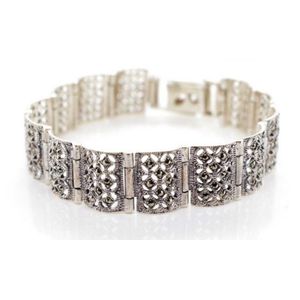Victorian Silver and Marcasite Bracelet - Elegant Mille Graine Design
You must be a subscriber, and be logged in to view price and dealer details.
Subscribe Now to view actual auction price for this item
When you subscribe, you have the option of setting the currency in which to display prices to $Au, $US, $NZ or Stg.
- Marcasite - Marcasite is a mineral, iron sulphide, but is rarely used in jewellery. Instead marcasite is the name given to iron pyrites, the mineral sold as marcasite which is identical in copmosition to iron sulphide but crystalises as a cube, making it more suitable for jewellery. It is a brassy yellow in colour and is also known as "fool's gold", and sits well with silver rather than gold becasue of its colour.
Marcasite has been used in jewellery since ancient times and became popular again in jewellery in the 18th century, continuing through to the early 20th century, with the settings becoming cheaper as time progressed, eventually earning the sobriquet "costume jewellery" along with other cheap jewellery that was made for a prevailing pattern and meant to be changed with each new outfit. - Victorian Period - The Victorian period of furniture and decorative arts design covers the reign of Queen Victoria from 1837 to 1901. There was not one dominant style of furniture in the Victorian period. Designers used and modified many historical styles such as Gothic, Tudor, Elizabethan, English Rococo, Neoclassical and others, although use of some styles, such as English Rococo and Gothic tended to dominate the furniture manufacture of the period.
The Victorian period was preceded by the Regency and William IV periods, and followed by the Edwardian period, named for Edward VII (1841 ? 1910) who was King of the United Kingdom and the British Dominions and Emperor of India for the brief period from 1901 until his death in 1910. - Openwork in Jewellery - Openwork, also known as pierced work, is a decorative technique used in jewellery making that involves removing or cutting out sections of metal from a piece of jewellery to create a pattern or design. This technique can be used in a wide range of jewellery styles, including necklaces, bracelets, earrings, and rings.
Openwork jewellery can be made using a variety of different techniques, including hand carving, sawing, and laser cutting. The design can be simple or complex, and can feature a range of different shapes and motifs, from delicate floral patterns to bold geometric designs.
One of the advantages of openwork jewellery is that it can add visual interest and depth to a piece without adding a lot of weight or bulk. This can be particularly appealing in larger pieces, such as necklaces and bracelets, where heavy materials can be uncomfortable to wear.
This item has been included into following indexes:
- bracelets and bangles - marcasite 51
- bracelets, material - other materials / styles 1,517
-
bracelets, silver
- silver link 302
- silver, other 1,181
Visually similar items

A gold cocktail bracelet by Depose, comprising pierced abstract links, in textured finish, in 18ct gold, total weight 81.0gms, total length 200 mm.

A silver stone set bracelet, cannetille work plaque links each set with a turquoise bead.

An 18ct white gold diamond bracelet; featuring 20 geometric links each centring a round brilliant cut diamond surrounded by 16 round brilliant cut diamonds. Estimated diamond weight 340 = 2.00ct. Wt. 18.7g.

An Art Deco style sterling silver bracelet; plaque links set with marcasites. Length 180 mm x 20 mm. Wt. 54.4g.
